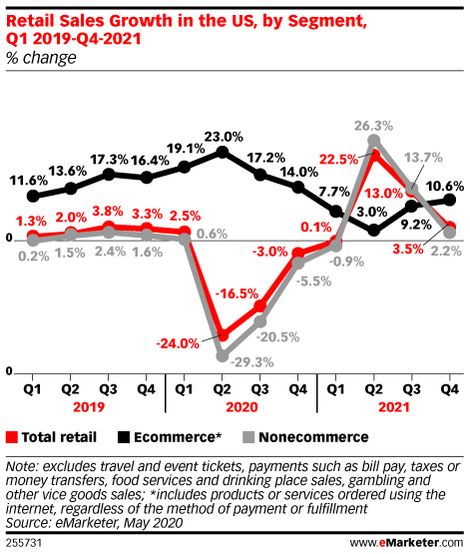Back in February 2020 (ah, a simpler time), total US retail sales were steadily chugging up a modest incline. EMarketer had predicted 2.8% growth, which would have been equal to $5.621 trillion in total US retail sales. It sounded like good news.
Well, we all know it didn’t exactly turn out that way. When the pandemic took hold, it took the economy down with it. The forced store closures, stay at home orders and job losses greatly reduced the purchases of nonessential items. Although there are now signs of recovery, the sharp, sudden dip means there will still be an overall 10.5% decline in total US retail sales this year, with a 14.0% drop in brick-and-mortar sales.
Yet, it’s not all doom and gloom for the entire retail category. E-commerce is poised to grow 18.0% this year, following an already strong 14.9% gain in 2019. The nature of the pandemic pushed consumers deeper into digital shopping territory. Even people who rarely or never shopped online, like some Boomers, found themselves turning to e-commerce more frequently. When people were ready to spend, online shopping felt like the safest option. Even as our communities reopen, this still feels like a less risky and more convenient option for many purchases.

Naturally, this has been a boon for Amazon, as well as some of the other big retailers. Amazon’s latest financial statement revealed that the company had totaled a revenue of $88.9 billion in Q2 2020, compared to $63.4 billion in Q2 2019 – a huge 40% year-on-year growth in net sales. This figure is despite the additional $4 billion in costs allocated during the quarter to keep its customers and employees safe from Covid and also to increase its delivery capacity. In April, Amazon claimed it was expecting a $1.5 billion loss in the due to such costs, but managed to double profit instead, from $2.6 billion in Q2 2019 to $5.2 billion in Q2 2020. The company also stated that it had increased its grocery capacity by 160% amid heightened demand during Covid-19, causing grocery sales to triple on a year-on-year basis in Q2.
Of course, this is the gold-standard example of successful e-commerce, but it goes to show just how much action is taking place digitally. It has become increasingly important for retailers to have an online presence if they want to survive. But the competition is pretty steep. Companies that have already embraced the e-commerce phenomenon are constantly evolving to keep pace with the ever-changing consumer mindset and the state of the economy.
But every good marketer knows it’s not as easy as setting your website live and waiting for orders to come in. There’s a lot of noise to cut through at the moment. Some tips for attracting customers in our current climate include:
Personalization – Customers spend 48% more when their shopping experience is personalized. Plus, 57% of online shoppers are comfortable with sharing their personal information with a brand if it benefits their shopping experience. When personalized is done right, a customer will feel like you’re reading their mind. This emotional response generates a sense of loyalty. To achieve the highest ROI, retailers need to embrace and make personalized commerce a reality for their consumers’ shopping experience.
Influencer and Celebrity Endorsements – As much as people roll their eyes at influencer marketing, it really does work. In 2020 and beyond, the trend will continue to grow and evolve as 65% of influencer marketing budgets will increase this year alone. And 7% of companies are planning to invest over a million dollars per year towards this strategy. The key is to garner celebrities and people with massive followings to endorse products at a more affordable level, combined with social commerce to drive sales directly from social.
Interactive Product Visuals – In 2020, online reviews are not enough to convince a customer to buy a product. Modern consumers need to trust the company, product and experience before purchasing. That’s why high-resolution images matter in e-commerce sales. But static images are no longer enough, either. Consumers demand more, such as 360-degree viewing images that let potential buyers view all angles of the product.
As we look forward to the remainder of the year, the forecast is not too shabby. Of course, we have no way of knowing where the fall months will take us, as far as new waves of the virus and what impact that will have. Yet, despite many having pulled back their spending amid coronavirus and an impending global recession, three quarters of consumers around the world are not planning on reducing their spending during Christmas this year. New research from Rakuten revealed that 87% of global shoppers will still be shopping for the holidays, and more than half (57%) expect to make a purchase on key days like Black Friday. So now is the time for businesses to get their online operations up to optimal performance. No doubt, consumers will turn to e-commerce for a large portion of this spending.



